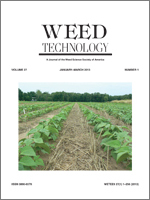In Alaska Conservation Reserve Program (CRP) lands, succession of fields planted with grass and clover to shrubs and small trees is resulting in program compliance problems related to ease of reconversion to crop lands. Standard practice for slowing this succession is mowing every 2 to 3 yr, which does not kill the woody vegetation. A field study was conducted at three sites over 2 yr to determine if 2,4-D (2.2 kg ae ha−1 2-ethylhexyl ester) or triclopyr (2.2 kg ae ha−1 butoxyethyl ester) applied broadcast or 2,4-D (2.2 kg ae ha−1 2,4-D dimethylamine salt) or triclopyr (1.7 kg ae ha−1 triclopyr triethylamine salt) applied with a Diamond Wet Blade™ mower (DWB) would result in longer shrub control compared to mowing. Mowing was conducted at both 15 and 45 cm above ground level and herbicides were applied with the DWB at three rates. Measurements 2 yr after treatment (YAT) confirmed that both herbicides reduced shrub cover about 50% compared to controls. Reduced rates of the herbicides applied with the DWB did not result in decreased shrub control. Grass cover was negatively correlated with shrub cover. Typically, mower height did not alter treatment effects. Treatments had little impact on forb cover and composition 2 YAT, with the exception of fireweed, which was generally reduced where herbicides were applied. Application of 2,4-D and triclopyr does not decrease the frequency of shrub control in CRP lands in Alaska. Use of 2,4-D and triclopyr with or without mowing resulted in no widespread improvement over the current practice of mowing to 15 cm every 2 to 3 yr.
Nomenclature: 2,4-D; triclopyr; fireweed, Chamerion angustifolium (L.) Holub ssp angustifolium.
En tierras del Programa de Reservas para la Conservación (CRP) de Alaska, la sucesión de campos sembrados con zacate y trébol a arbustos y árboles pequeños está resultando en problemas para el cumplimiento del programa en relación con la facilidad de reconversión a tierras agrícolas. La práctica estándar para retrasar esta sucesión es la chapia cada 2 a 3 años, la cual no mata la vegetación leñosa. Se realizó un estudio de campo en tres sitios durante 2 años para determinar si 2,4-D (2.2 kg ae ha−1 2-ethylhexyl ester) o triclopyr (2.2 kg ae ha−1 butoxyethyl ester) aplicados con aspersión generalizada o 2,4-D (2.2 kg ae ha−1 2,4-D sal dimethylamine) o triclopyr (1,7 kg ae ha−1 triclopyr sal triethylamine) aplicados con una chapeadora Damon Wet Blade TM (DWB) resultarían en un control más duradero de arbustos en comparación con la chapia. Se chapeó a 15 y 45 cm sobre la superficie del suelo y los herbicidas se aplicaron con el DWB a tres dosis. Mediciones 2 años después del tratamiento (YAT) confirmaron que ambos herbicidas redujeron la cobertura de arbustos en cerca de 50% en comparación con los testigos. Dosis reducidas de los herbicidas aplicados con DWB no resultaron en reducciones en el control de arbustos. La cobertura de zacates estuvo negativamente correlacionada con la cobertura de arbustos. Típicamente, la altura de la chapeadora no afectó el efecto de los tratamientos. Los tratamientos tuvieron un impacto menor en la cobertura y composición de plantas herbáceas de hoja ancha a 2 YAT, con la excepción de Chamerion angustifolium, la cual fue generalmente reducida cuando se aplicó herbicidas. La aplicación de 2,4-D y triclopyr no reduce la frecuencia de control de arbustos en tierras del CRP en Alaska. El uso de 2,4-D y triclopyr con o sin chapia no resultó en una mejora en comparación con la práctica actual de chapear a 15 cm cada 2 ó 3 años.





